Farewell to ABC's George and Rita Fenwick
After successfully leading American Bird Conservancy for nearly 24 years, George Fenwick (along with Rita Fenwick, our long-time head of Development) is stepping down on May 31. In this era of change at ABC, we asked some of ABC's best friends to share their memories with us. Here are their perspectives. Thank you all!
From Jonathan Franzen: "Small Miracle for a Worker of Large Ones for Birds"
Because ABC wouldn't exist without him, it's safe to say that nobody in the world has done more for birds in the past quarter-century than George Fenwick (though Rita Fenwick may come close). ABC's huge conservation achievements accrue directly to George, but you wouldn't guess it if you met him in person. He's an extremely funny guy, sometimes a very silly guy, and he's unfailingly self-deprecating and self-critical — always more mindful of what he hasn't yet accomplished than of what he has.
George is a pretty skilled birdwatcher, too, though you'll never catch him admitting it. The first time I birded with him was in Bolivar Flats, Texas — an enjoyable excursion for which I later had to pay by serving for nine years on ABC's board. We've also birded together in Bolivia and Colombia, seeing some of the endangered species that ABC and its partners have helped safeguard: the Blue-throated Macaw, the Palkachupa Cotinga, and the many endemics of the Santa Marta Mountains.
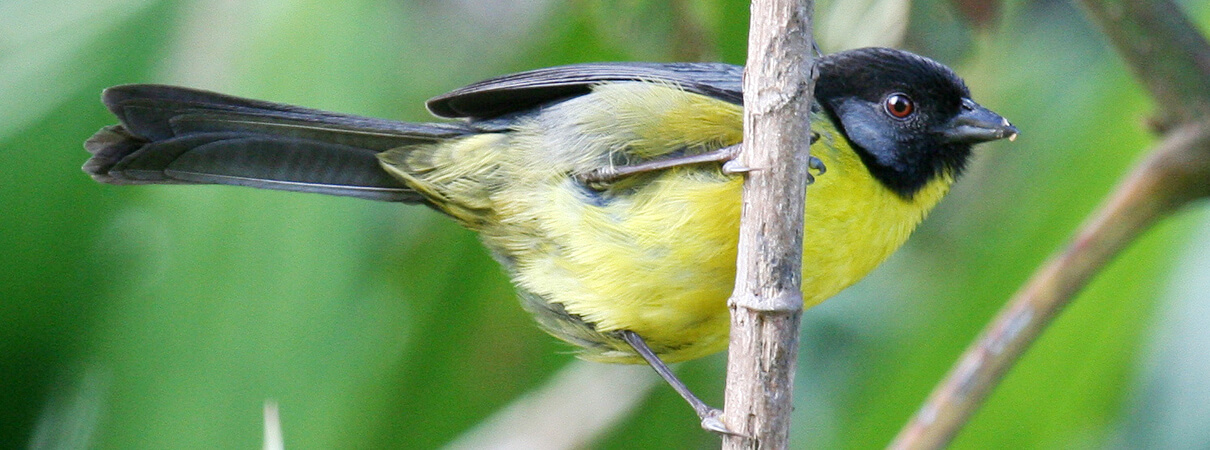
The Santa Marta Brush-Finch is one of many species endemic to Colombia's Sierra Nevada de Santa Marta Mountains, meaning they are found nowhere else in the world. Photo by Fabrice Schmitt
Only on one of those trips did I nearly succeed in killing George. We were walking on the paved road below the El Dorado reserve, a highland jewel created by ABC and its Colombian partner ProAves. The road cut across the side of a precipice with some mature fruiting trees clinging to it. As we were passing underneath one of them, I caught a glimpse of an unfamiliar bird, something sort of vireo-like. I raised the alarm, and George hurried over to try to see it. We started backing up the road, to get a better angle on the tree. George kept his eyes on where I was pointing, and he took one backward step too many — onto a spot where rain had taken a large bite out of the pavement. He sailed backward off the precipice. I ran to the edge, pretty sure I'd killed him. But somehow he'd made a soft landing, 15 feet below, in a small tree growing sideways out of the hillside. A small miracle for a worker of large ones for birds.
By Jonathan Franzen, novelist, essayist, journalist, translator, and ABC Board member
From Adrian Forsyth: "Conservation at a Grand Scale"
The U.S. Government's Small Business Administration claims “starting a nonprofit can be an extremely rewarding entrepreneurial experience.” That sounds lovely, but my experience of starting a nonprofit is that it is more akin to starting a family: It's a demanding job you can't quit and one that will go on for decades. It will keep you awake at night and cause you to worry about things you never knew existed. However, while millions of years of evolution have prepared people to start and complete the rearing of family, relatively little will prepare one psychologically for starting a nonprofit.
You will discover that it is much easier to be an employee than to have employees. There will be many days when philanthropy seems populated by donors who are whimsical, imperious, irrational, and have the attention span of gnats. Yet sometimes you will be overwhelmed by the generosity and vision of your supporters. Sometimes your employees will be as precious to you as your children. Not surprisingly then, many nonprofits fail in their infancy because their founders do not have the commitment and ability to ride this start-up roller coaster.
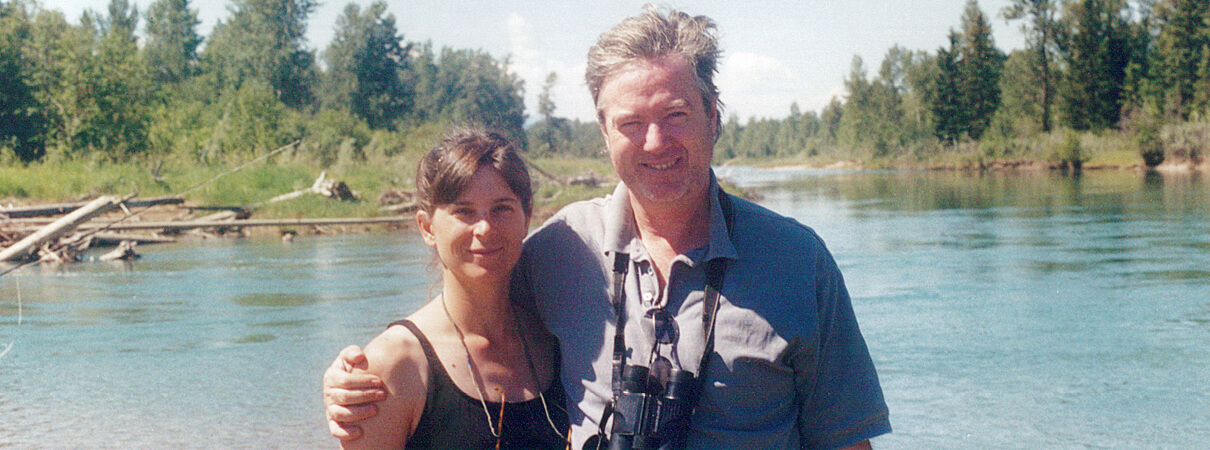
George and Rita Fenwick in Flat River, MT, in 2000. Photo by Dan Casey
That the Fenwicks created ABC right when they were also raising a clutch of their own says much about the depth of their work ethic and ability. Few could have accomplished what they have achieved in building one of the finest organizations doing real conservation at a grand scale.
I first encountered ABC at the dawn of the millennium when the pleasantly persuasive Mike Parr convinced me to share office space in a DuPont Circle row house. For the better part of a decade I cohabited with ABC's downtown crew in two successive places. I was also trying to rear two environmental nonprofits. This helped me understand the challenges George and Rita faced in working both domestically and partnering with local bird conservation groups active in remote parts of Latin America. They were doing well in no small part because they hired and empowered good people who shared their obsession with saving birds. That sounds easier than it actually is — both to find such people and then to let them run with it.
My day job was to be on the philanthropic side of the nonprofit fence, making foundation grants to nonprofits active in Latin America. I never had any hesitation about funding ABC because I knew intimately that their employees would not be lollygagging on Facebook but working hard at their mission. That attitude flows from the top.
After stints working in much bigger conservation organizations it was also refreshing to see an organization that continuously supported small partner nonprofits in Latin America and never attempted to steal their thunder. This is in no small part due to the self-effacing character of the Fenwicks. Their true partnership attitude is much of what has allowed ABC to raise the profile and build the capacity of Latin American bird conservation groups.
The Fenwick's transparent modesty and approachability also made it easy to beg from them. They were so good at fundraising that I started to see them as potential donors to my causes. George was never an easy sell but horse trading with him was always fun because he is ever witty, humorous, and holds nothing but conservation as the currency of debate. Rita has proven to be that rarest of birds in the nonprofit sector: someone who will actually connect you with one of her donors.
Over the years the Fenwicks helped me with grants both large and small. As a result some key conservation landscapes and a birder's pantheon of exquisite species enjoy a good future. Thank you, George and Rita.
By Adrian Forsyth, Executive Director, Andes Amazon Fund
From Wendy Paulson: "Steady Focus on Saving Species"
My association with George Fenwick began at The Nature Conservancy many years ago, when he directed ecosystem conservation and served as Acting Director of Science. I always appreciated our conversations and learned a lot from them.
When George founded ABC, I wondered about the prospects of another organization focused on birds. But it became clear almost immediately that ABC would focus on areas neglected by other bird-centric groups.
The organization quickly earned my respect and that of many other conservationists.
George has been fearless in addressing difficult issues — cats, pesticides, windows, and towers that kill. He's been persistent and insistent in developing measures and programs to mitigate those threats and that has placed ABC in a unique and important position among conservation groups.
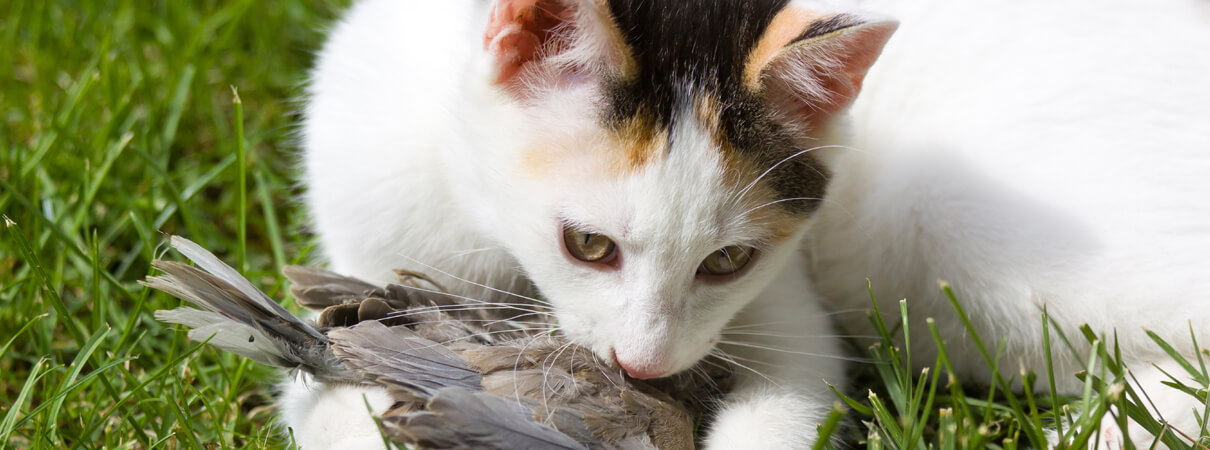
ABC is steadfast in its commitment to fighting the toughest issues of bird conservation, such as that of feral and outdoor pet cats. Photo by istockphoto
I've also appreciated and admired George's steady focus on saving species and habitat when the trend in many conservation organizations has been to move away from those goals. I've had the privilege of visiting some of the conservation birding lodges ABC helped establish with local partners, and see them as a model conservation tool. Their quarterly publication, Bird Conservation, is one of the very few I read cover to cover — and always appreciate the learning experience it offers.
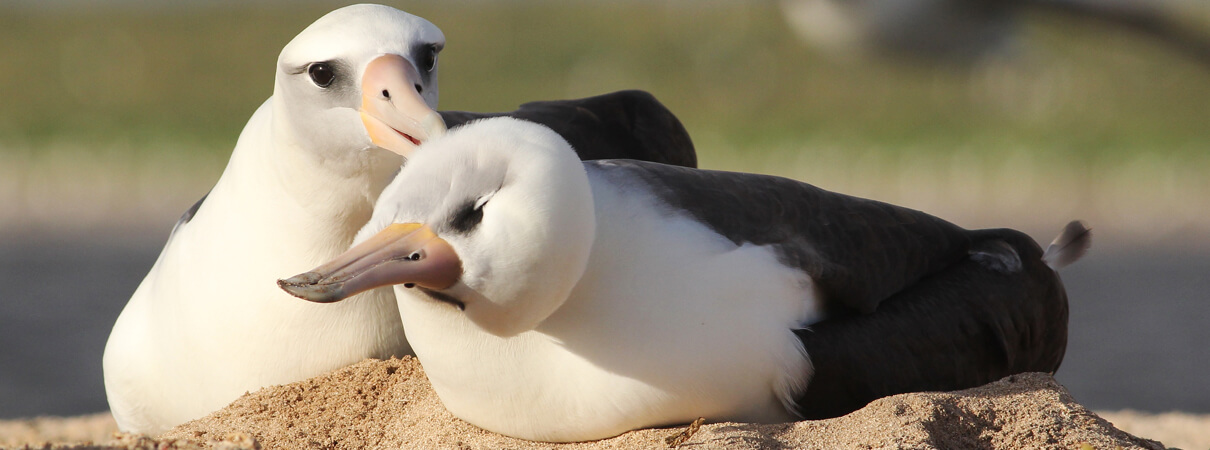
The ACAP protects albatrosses — such as these Laysan Albatross — and petrels by coordinating international activities—conservation measures, research, the exchange of information, and increased public awareness—that benefit these birds. Photo by Cameron Rutt
When we lived in D.C., George visited regularly to give me updates on ABC's work and my admiration only grew for the organization's clear-eyed focus on areas not attended to by others. He kept me regularly informed about the Agreement on the Conservation of Albatrosses and Petrels (ACAP) treaty — information that I was able to use to advocate for U.S. support (still pending). It was fitting — and meaningful — to be able to participate with George in an event at Patuxent Research Station in Maryland where then-President George W. Bush announced collaborative plans for increasing stopover habitat for migratory birds.
Though I've worked only indirectly with Rita, I know that she and George operate as a team. What a fine and effective organization they've built and led for over 20 years! I'm confident both will continue to be leading and effective voices for birds and conservation in the years ahead.
By Wendy Paulson, Chair, Bobolink Foundation
From David Harrison: “Hundreds of Brilliant Blue and Yellow Birds”
In February 2015, I joined George and Rita Fenwick on a trip to visit ABC partners and projects in northeast Brazil. One of the memories that stands out for me was our visit to the Lear's Macaw reserve — Canudos Biological Station — a project ABC supports with Fundação Biodiversitas.

The Canudos Biological Stations — a Brazilian reserve supported by ABC and partner Fundação Biodiversitas — is one of only two known breeding sites for the Lear's Macaw. Here, George Fenwick scans for macaws, while the reserve's red sandstone cliffs and canyons are visible in the background. Photo by David Harrison
This reserve is in spectacular country reminiscent of southern Utah, with eroded red sandstone cliffs and canyons. ABC and Biodiversitas established the reserve to protect one of only two sites known to have Lear's Macaws. Thanks to our efforts, the macaws had rebounded from a low of 70 wild birds in the 1980s to 1,300 today. There are infrastructure improvements as well: When we had visited a few years earlier, there were no accommodations on the reserve, so we stayed in a run-down hotel in town where Rita nearly electrocuted herself because of faulty electrical wiring! Fortunately, a visitor lodge had since been completed and we were able to stay in comfortable lodging right on site.
The morning after our arrival we made our way to the birds' roost site in the predawn darkness and could hear their squawking before we could make out passing silhouettes. As the sun came up, the birds took off and circled in noisy flocks. The sight of hundreds of brilliant blue and yellow birds against the red canyon walls was unforgettable!
By David Harrison, ABC Board Member
From Jim Brumm: “Model for Bird Conservation Worldwide”
What can one say about George and Rita that would even come close to describing what they have meant to bird conservation and to capturing what they have achieved?
I marvel at what they have created by founding ABC and recruiting to it such a talented and dedicated team of conservationists. The conservation achievements of ABC speak for themselves. Under George and Rita's leadership, guidance, and mentoring, ABC and its staff have filled an important space in bird conservation in the Americas and have served as a model for bird conservation worldwide.
I feel so honored to have been selected to join the Board of ABC and to have served for awhile as its Chair. Working with George and Rita has been a highlight of my life and I will always be grateful for what they and ABC have taught me, and for giving me the foundation to use this knowledge and experience on the boards of other conservation organizations I have joined. Most of all, any time spent with George and Rita is just lots of fun. They have such a joy of life and it is contagious.
I will miss, and I know all of you will miss, George and Rita.
By Jim Brumm, Former ABC Board Chair
From Victor Emanuel: “Saving Hummingbird Haven”
One memory of George Fenwick I will always cherish was the time I attended an ABC Board meeting to ask ABC to play a leading role in raising $350,000 to save Paton's Hummingbird Haven — a premier birding and hummingbird spot in Patagonia, Arizona.
I had gotten involved because Ann Cullen Smith — who was about 103 at the time — called to ask me to help save Paton's. When she was younger Ann had come on tours with my company (Victor Emanuel Nature Tours, or VENT). I made my pitch to ABC's Board, explaining that thousands of birders from all over the world came to Paton's every year and that by helping save it ABC would enhance its visibility to birders.
To my delight, ABC agreed. In turn, Tucson Audubon agreed to receive and manage the property once ABC purchased it.
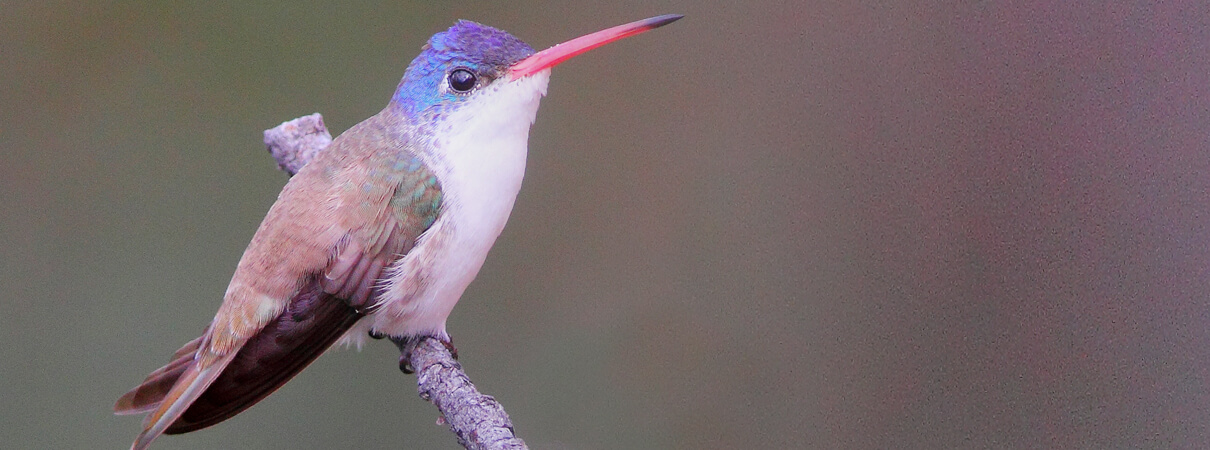
The Violet-crowned Hummingbird is one of 213 bird species — including more than 15 species of hummingbird — that have been seen at Paton's Hummingbird Haven. Photo by Greg Home / Natural Elements Productions
To raise funds, ABC put the project on its website with a drawing of a hummingbird feeder and the message, “Fill the feeder.” As donations came in, the red “liquid” in the feeder grew. Hundreds of people donated, and we raised enough to purchase the property.
After the property was purchased, George and I were asked to speak at the dedication ceremony. It was a great thrill to walk onto the property and see a large 15-foot-high kiosk featuring a photograph of George and the story of ABC's role in saving Paton's.
That day we met Bonnie Paton Moon, daughter of Wally and Marion Paton. (Bonnie's parents were local legends who for 35 years had invited birders into their yard to see the extraordinary hummingbird species attracted to their many nectar feeders.) In her book, Journey Home, she tells the story of the effort to save her parents' property and the critical role that George and ABC played.
Thank you George.
By Victor Emanuel, Former ABC Board Member and founder of Victor Emanuel Nature Tours
From Tino Aucca: "We leaders … are not superheroes."
We leaders are normal people. We are not superheroes from a comic book. And we often struggle to manage the many challenges and problems we must face to achieve our goals. Our actions impact the happiness of our family, team, mission, all the people who benefit from our actions, and all the creatures and habitat that we are protecting for the entire world. And sometimes we must make sacrifices to meet those commitments. This is a struggle George knows well, because he lived it.
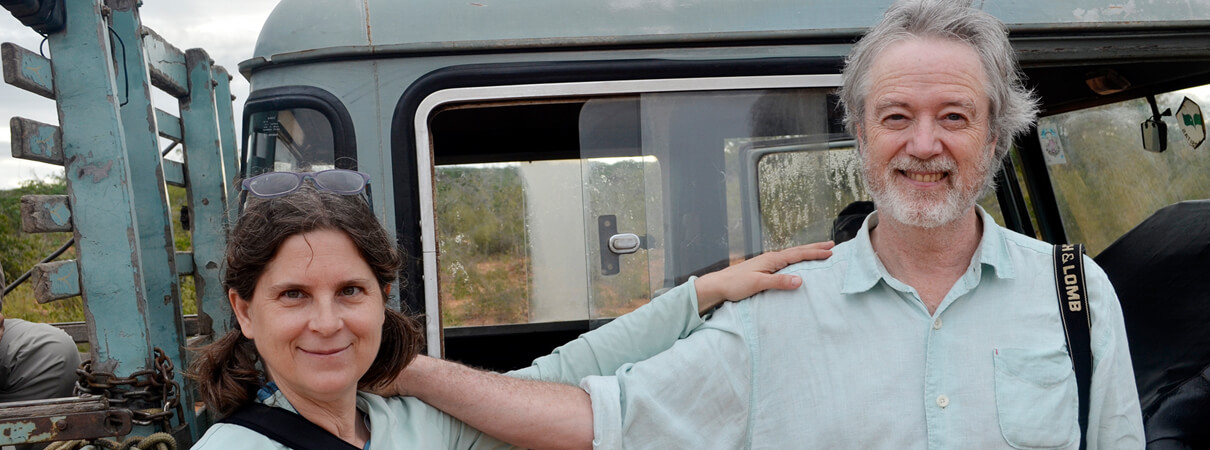
George Fenwick and Rite Fenwick. Photo by David Harrison
Thank you so much, George, for being a great friend, brother, father, and leader.
By Tino Aucca, Director of ABC's Peruvian Partner ECOAN


















































